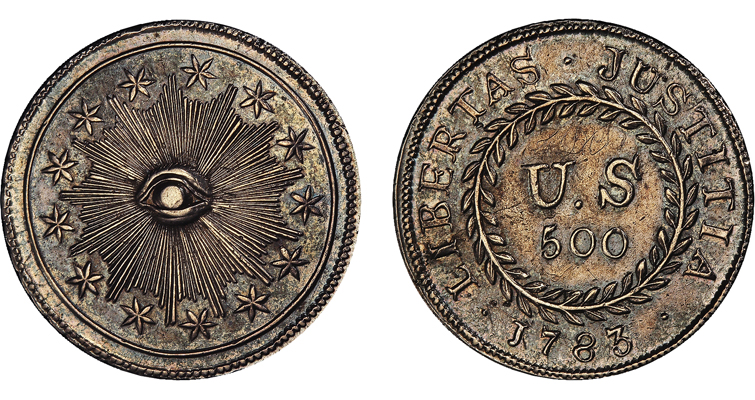Four years of extensive research by U.S. numismatist David McCarthy has confirmed the 1783 Nova Constellatio plain obverse “quint” pattern is the first coin officially struck by authority of the American government more than 230 years ago.
The results of McCarthy’s research on the unique, early American experimental silver coin are in the August 2017 edition of The Numismatist, the official journal of the American Numismatic Association (ANA). The coin, which was once in the hands of one of U.S. Founding Fathers Alexander Hamilton, is now insured for $5 million USD.
“Although the coin was discovered in 1870, it was misattributed. We now have compelling evidence that it is ‘the first that has been struck as an American coin,’ as described in the April 2, 1783, diary entry of Robert Morris, a signer of the Declaration of Independence and the U.S. government’s first superintendent of finance,” said McCarthy, who’s a senior numismatist for Kagin’s in Tiburon, Calif.
“The quint and a subsequent set of coins were created in Philadelphia in April of 1783 under authority of the Treasury some nine years before the next coins would be struck by the U.S. government. It would have been valued at 500 units in a proposed system that would range from 5 to 1,000 units.”
“It’s a national treasure that was hiding in plain sight until all the pieces of the puzzle recently came together,” said Donald Kagin, president of Kagin’s.
“This was the first use of the vital and enduring decimal system to be established in the western world.”
234 YEARS AGO
During the 1770s and 1780s, several states and private individuals manufactured coins; however, the 1783 Nova Constellatio plain obverse “quint” was the first coin that was struck and paid for by the U.S. government, according to McCarthy’s research.
After examining McCarthy’s research, early American coin researcher and writer John Dannreuther, of Memphis, Tn., confirmed the findings.
“There is a first United States coin, as we have written evidence [in the April 2, 1783, diary entry of Robert Morris, U.S. superintendent of finance] that one was delivered: ‘I sent for [metallurgist] Mr. [Benjamin] Dudley who delivered me a piece of silver coin being the first that has been struck as an American coin.'”
“The only coin that logically could be this coin is the Plain Obverse quint,” said Dannreuther, who was also the ANA’s 2007 Numismatist of the Year.
“There are numerous things that bring us to this conclusion, the first being that ‘Nova Constellatio’ is not found on the Plain Legend quint. One does not remove legends, they are added. Secondly, the number of dies noted in the literature can be made to match only by having one die ground down and re-engraved. After overlaying the two quint types, it became obvious that the Plain Obverse die’s eye matched the die with Legend eye. Since this is the highest point of the coin, it is the lowest part of the die, as well as the center, it would be logical to leave a small amount of this area as a starting point for the new die. The rest of the die’s detail was removed by the grinding process, of course. Thirdly, the two quint dies obviously were engraved by two different hands. Since we know that the die with Legend coins match the other denominations in style, as well as having the ‘Nova Constellatio’ legend, the Plain Obverse has to be the first one—thus, it is the first United States coin.”

